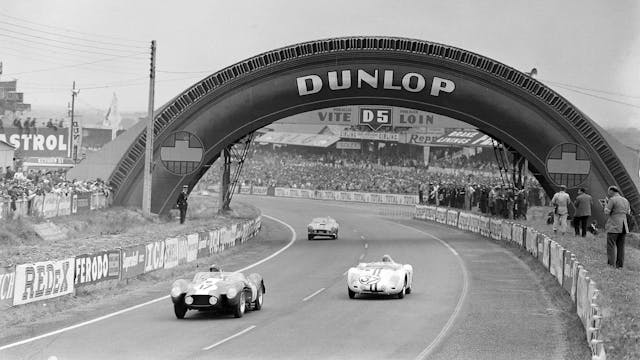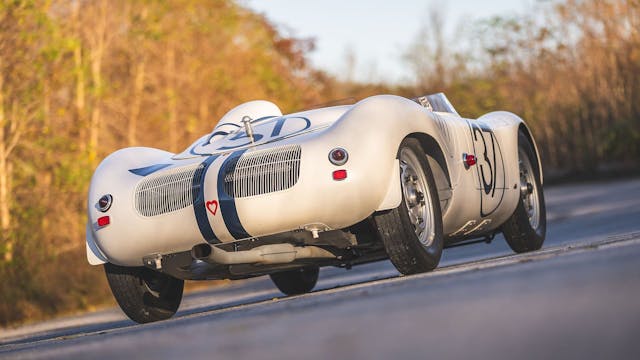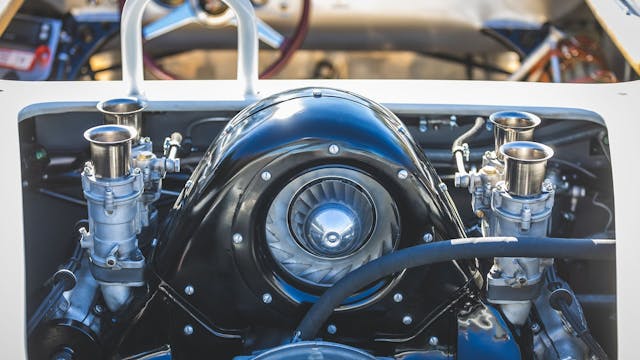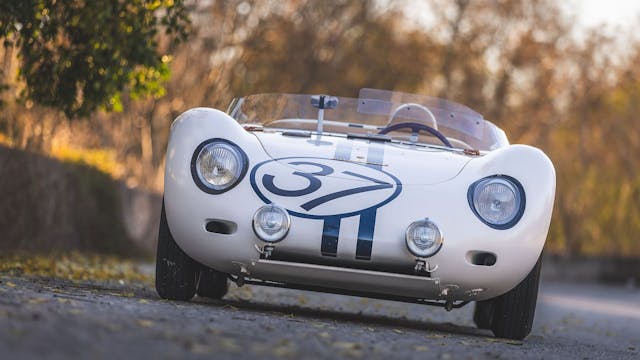Lucybelle III, A Glorious Little Porsche 718 RSK, Is Ready to Head Back to Le Mans
If you think that size or cylinder count are deciding factors in what makes a race car successful, you probably aren’t familiar with Porsche’s 718 RSK.
Under its softly curving aluminum body is a four-cam, four-cylinder engine, a design that established Porsche as a dominating force in international racing in the 1950s. That domination began with the 550 A, which the marque calls its first “thoroughbred” race car, and was cemented with this model, the 718. From 1953 to the early ’60s, versions of the 718 racked up over 1000 victories in the hands of both Porsche factory drivers and privateers, and few have survived competition as successfully as this 1959 718 RSK Spyder, known as Lucybelle III, offered by Broad Arrow at its Amelia Island auction.

Porsche only made 34 RSK Spyders. Chassis numbers 718-001 through 718-010 were reserved for factory werks drivers. Only 24 were built and sold to customers, beginning with chassis #710-011—Lucybelle III is chassis 718-024. Delivered to Ed Hugus at Le Mans in 1959 wearing Silver Metallic with a beige interior, the model was powered by the engine for which Porsches had become famous: A four-cam four-cylinder designed by Ernst Fuhrmann.
Born in Pennsylvania, Ed Hugus was a WWII paratrooper who, shortly after returning from Japan in 1946, started an MG dealership in Pittsburgh. Five years later, in 1951, he joined the SCCA and ran his first race. He had quite the hand for it, though his friends remember him as someone who “never beat his own drum,” and over the next 20 years raced many times at premier sports car events such as the 24 Hours of Le Mans and the 12 Hours of Sebring. The “III” in the name of this car harkens back to the original Lucybelle, a 550 Spyder with which Hugus won the 1500cc class at Le Mans in 1957. (The second Lucybelle was a Ferrari.)

Since Hugus was a proud American, he had his 718 RSK repainted (overnight while trackside at Le Mans!) in the appropriate American racing livery: two blue stripes over a white base. 20 hours into the race, it looked like he had his second class victory at Le Mans in the bag: after 240 laps, he was first in class and in fourth place overall. Then the engine dropped a valve: Hugus, his co-driver Ray “Ernie” Erickson, and Lucybelle III were out of the race. In hindsight, they were an agonizing 30 laps short of the class winner, a Lotus Elite. Le Mans in the ’50s was a cruel mistress: Of the 11 cars in Lucybelle’s class, only two finished the race; four others did not finish, and four failed to start.
According to the book, Porsche Carrera, the engine was repaired and put into a 356 1600 GS/GT Coupe; Lucybelle III was shipped back to the U.S. with a fresh engine.

After her foray on the international stage, Lucybelle III continued to race in the U.S. thanks to her second owner, an avid SCCA racer named Don Ives. Phoenix, El Paso, Road America—she crisscrossed the continent, even notching a fourth-place finish at the 1962 Pikes Peak Hill Climb, then sanctioned by USAC, in the under 2.0-liter class. She finished her in-period racing career at Aspen Raceways in 1963 and disappeared from the track for over a decade, until she was bought by William Franklin, who ushered her into an appropriate retirement. She raced at the Monterey Historics in ’77 and ’78 and again in ’84 and ’86.
From there, Lucybelle III entered what one today might call her hermit era: Once entering a private collection in 1994, she was seen in public only once for the next 25 years, when she emerged in 1998 at the Amelia Island Concours to claim the Road & Track Trophy. Then, it was back into the shadows until her first public sale in 2018.

After that, it was time for a restoration. As they began their efforts on Lucybelle III’s bodywork, the restorers at Rare Drive Inc. fully expected to find period repairs that are so typical with race cars of any vintage. They were shocked to find the body in surprisingly original shape, and elected to leave the aluminum body on the frame. They did, however, source a proper engine: An unstamped 547/3 Carrera four-cam. Once it was rebuilt by Peter Hofmann and Karl Hloch, along with fresh suspension components, she needed a new tan top, a new rearview mirror and driving lights, a set of date-coded alloys, and a painstaking repaint—and here she is, looking just as she did when Ed Hugus first named her Lucybelle III at Le Mans in 1959. The 30-month restoration has already earned her entry into one of the world’s most prestigious concours: At Pebble Beach in 2021, she won third place in the Postwar Racing Class.
As a Le Mans veteran, she’s eligible to return there, before the modern running, to compete against other vintage race cars in the Le Mans Classic. She’s also, of course, eligible for other vintage events of that prestigious caliber, but we can think of no more fitting tribute to Porsche’s racing legacy than to hear that four-cam engine singing down the Mulsanne Straight. She may wear a remarkably pretty face, but make no mistake: this Porsche represents the legacy of a little Goliath.
***
Check out the Hagerty Media homepage so you don’t miss a single story, or better yet, bookmark it. To get our best stories delivered right to your inbox, subscribe to our newsletters.



Back in the 80″s, I owned 718-032, an ex-Porsche Salzburg (Piech family) hillclimb car. Wonder where it is now?
Wow! If only we knew in the ’80s what we know now, right? You had something truly special that most people don’t even know exists.
That is still my favorite engine of all time. It occasionally swaps spots with the 917 flat 12, but it’s mostly this. It’s one of the few engines (modern electronics notwithstanding) that I would not even consider attempting to build, myself. What a meticulous job that’d have to be! And with the current values the stakes would be *very* high.
Very neat, car looks very good.